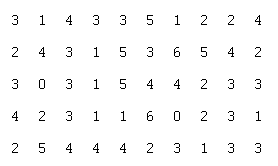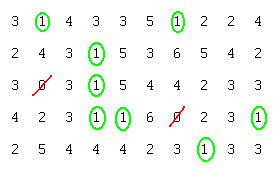

Can you please explain what a frequency table is? I am trying to help my son with his maths, but it's been 20 years since I was at school myself. |
Suppose you have a large data set (set of numbers). Divide the overall range of the data into classes. A frequency table is a way to show how many of the data items lie in each of the classes.
For example, suppose you did a survey on the number of people living in each house in a
street of 50 houses. The "raw" data set might look like:

A neater way to present this would be to make a note of how many houses had 0 people living
there, how many had 1 person, how many had 2 people, etc. This is known as finding the
frequencies of each of the data values. For example, we see that there were 2 houses with
no people living in them, eight houses with one person, etc.:

The results of finding the frequencies of each data value can be presented neatly in a
frequency table:
| Number of people per house | 0 | 1 | 2 | 3 | 4 | 5 | 6 |
| Frequency | 2 | 8 | 9 | 14 | 10 | 5 | 2 |
This procedure can also be followed if the data covers a wide range, by dividing the range into classes and making a note of the frequency of each class.
For example, consider the data set of 12 values (12 is not really "large", but as a simple
example it is enough to illustrate the procedure):

Divide this range of data into classes. One way of doing this, using nice regular intervals, is
15 to 19 , 20 to 24 , 25 to 29 , 30 to 34
If you look at the original set of data, you will see that three of the data values lie in the
class "15 to 19" (red), four lie in the class "20 to 24" (green), three lie in the class
"25 to 29" (blue) and two lie in the class "30 to 34" (yellow).

Summarising this gives the frequency table
| Data class | 15 - 19 | 20 - 24 | 25 - 29 | 30 - 34 |
| Frequency | 3 | 4 | 3 | 2 |
Frequency tables are compact ways of showing how the data values are distributed between the various classes. They allow you to see at a glance the most "popular" class (known as the "modal class"). They are also needed in order to draw graphs of the data, for example bar charts, histograms or pie charts.